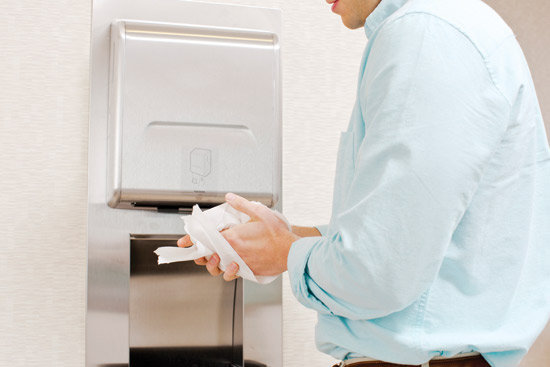Looking Good: New Paper Towel Dispenser Systems Score in Appearance, Sustainability, and User Preference
Specification decisions help users have the ideal hand-drying experience
![]() Continuing Education
Continuing Education
Use the following learning objectives to focus your study while reading this month’s Continuing Education article.
Learning Objectives - After reading this article, you will be able to:
- Detail the ways in which next-generation paper towel systems contribute to green building goals and affect public health considerations.
- Describe effective approaches to curtailing the spread of germs in order to create safe, healthy public facilities.
- Compare the effectiveness of various hand-drying methods in terms of personal hygiene and cleanliness of the public restroom facility.
- Specify paper towel dispensing systems according to universal design and ADA standards.
It's not often that a product can rest squarely on the three pillars of sustainability—environmental, economic, and social. While drying one's hands in a restroom may seem a simple act, it is one with far-reaching implications. With the wrong system, hand drying may be incomplete. It may be a way to transmit germs, causing illness that results in millions of dollars of downtime for employers, lost days for students, and inconvenience to the general public. Further, the wrong system can degrade the environment and generate unnecessary noise pollution, increased maintenance costs, and even safety concerns. Recent studies have reaffirmed that paper towels are the most hygienic and user-preferred method of hand drying in a public restroom1—and architects interested in creating fully sustainable spaces are well advised to closely examine this issue. The following article will present the urgent need to take steps to create healthy and safe public spaces, focusing on a key element of those spaces: restrooms. Existing hand-drying systems will be compared in terms of hygiene, environmental, and aesthetic characteristics. Also presented will be a short primer on specification considerations and best practices in next-generation paper towel systems.
Designing for Function, Health, and Waste Reduction
Today's green buildings demand solutions that promote the safety, health, and well-being of occupants, while enabling minimum possible energy usage and responsible sourcing of materials. Providing solutions that foster occupant health and hygiene can have a significant impact on a building's environmental performance, and offer the potential to earn credits in the U.S. Green Building Council's Leadership in Energy and Environmental Design (LEED) rating system, the preeminent green rating program in the U.S.

Photo courtesy of KIMBERLY-CLARK PROFESSIONAL*
Ideally, modern facilities feature a clean, crisp look and support public health goals.
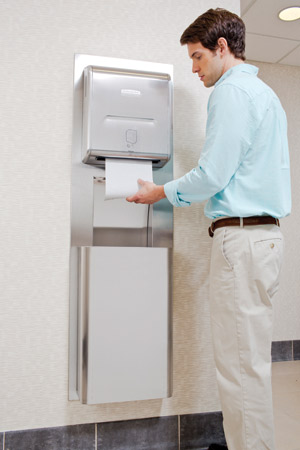
Photo courtesy of KIMBERLY-CLARK PROFESSIONAL*
Effective hand washing and hand drying are not only key to good restroom design in public spaces, they have implications for public health.
The importance of solutions that foster occupant health is underscored by research that shows that 98 percent of workers are affected by minor illness each year2 and 80 percent of minor illnesses are preventable.3 One contributing factor could be highly concentrated work environments often have high levels of germs. Viruses can live from 20 minutes to 2 hours on surfaces, including chairs, tables, and vending machines.4 Common areas are perfect sanctuaries for unwanted germs—water coolers, ATMs, door handles, conference tables, reception areas. Adults touch their faces an average of 15.7 times every hour,5 transmitting germs to the surfaces they subsequently touch. Handshakes can transmit viruses far beyond the hands of the person being greeted, including people outside the actual office.
Naturally, it is no surprise that a public restroom is another hot spot for germs. Florida researchers cultured four commercial aircraft and 18 restrooms,6 including those in a mall, hospital, offices, lecture hall, conference center, department stores, restaurants, airport, and resort. According to the study, “Faucets, soap and paper dispenser operating levers, and the exit door handle of restaurants and aircraft restrooms were more likely to have concentrations of microorganisms too numerous to count compared with other locations.” The study further found that “Cultures of high-touch sites in three restrooms located in different areas of a tertiary care hospital yielded six microorganisms that are responsible for two-thirds of healthcare-associated infections.”7
Personal hygiene habits have a direct correlation with contracting minor illnesses, particularly during flu season, and some companies have adopted the three-step approach of hand washing, wiping, and sanitizing as a way to keep workplace illnesses at bay. As has been published widely in the medical literature, proper hand washing is still the best way to reduce the spread of germs. Using disinfectant wipes kills germs on some of the dirtiest hot spots, such as doorknobs, keyboards, and phones. The third line of defense is to use hand sanitizer—it kills 99.9 percent of germs, and can reduce sick days by 21 percent in office environments.
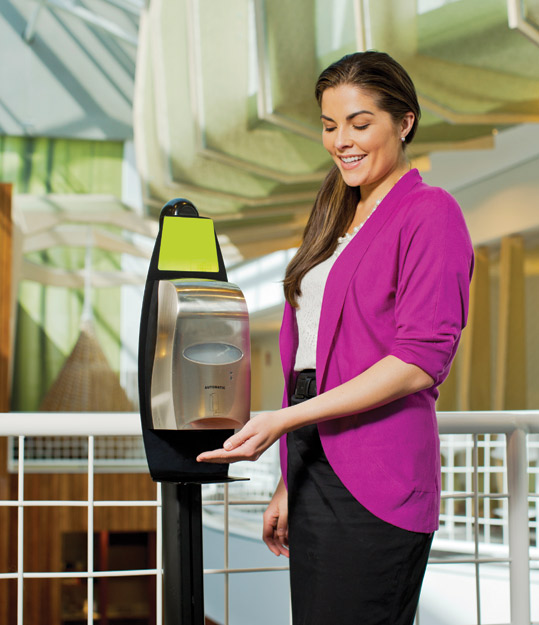
Photo courtesy of KIMBERLY-CLARK PROFESSIONAL*
Using hand sanitizer kills 99.9 percent of germs* and can reduce sick days by 21 percent in office environments.
*Instant hand sanitizer kills 99.9% of germs in as little as 15 seconds.
While personal hygiene habits do reduce minor illness, architects and owners are concerned with building for high-traffic areas and controlling potential public health issues. Of prime importance are solutions that combine functional design with health and waste reduction goals.
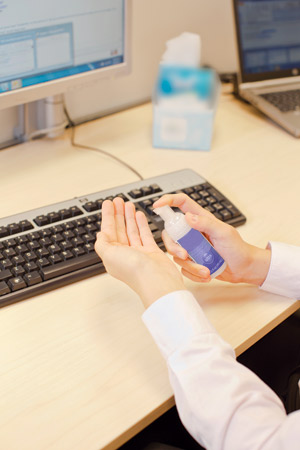
Photo courtesy of KIMBERLY-CLARK PROFESSIONAL*
There are several germ “hot spots” throughout a typical office space.
Restrooms—A Key Component of Healthy Public Spaces
While in times past, public restrooms were not a major focus of attention, today the concern with curtailing the spread of germs and disease has made having safe and sanitary restrooms a must for any establishment. An unsightly appearance of the restrooms in a restaurant, hospital, school, office building can create the perception of uncleanliness throughout the rest of the facility. Patrons may be enthusiastic about the food in a restaurant or visitors may be impressed with a hotel's ambience, for example, but if they see wet floors or unclean conditions in the restroom, they may question the sanitary standards of the entire operation. Faced with these conditions, users may not wipe their hands adequately, or forego hand washing altogether. On the other hand, modern and clean restrooms are an opportunity to enhance and improve the image of a facility. For example, an opera house might have nice cloth towels and exceptional features and a contemporary university student center restroom would have clean modern lines and the same high-end look as the rest of the facility.
One key way that facility managers are upgrading their restrooms for minimal to no incremental investment is through touchless operation technologies. Consumers do not want to touch surfaces, buttons, or knobs that have been repeatedly handled by others, and have been shown to harbor germs for hours. Manufacturers have responded with faucets, sinks, dryers, and toilets that operate automatically, and facility managers seeking improved hygiene, better image of the restroom, and reduced consumption of natural resources have increasingly invested in their products. Accordingly, automatic touchless operation has virtually become the norm in today's high-traffic public restrooms.8 Earlier models had limited battery life which frustrated maintenance teams and users alike, but newer technologies offer AC power or innovative dispensing technology capable of two to four times the traditional battery life span. Newer models have a more stylish look, too, creating a more upscale restroom while advancing the environmental agenda as toilets, sinks, and hand-drying mechanisms reduce consumption and save resources by allowing patrons to use only what is necessary.
New towel and skincare systems are more hygienic by eliminating touch points and controlling the dispenser to minimize waste. Foam skincare products reduce product usage and provide the same benefits of liquid. Further, recyclable plastic cartridges are more hygienic than their “refillable” counterparts since the refill systems are prone to bacteria growth.

Photo courtesy of KIMBERLY-CLARK PROFESSIONAL*
Well-maintained restrooms can enhance and improve the image of a facility.
Widely regarded as the most hygienic approach, touchless products when installed properly have also been recognized as Americans with Disability Act (ADA) compliant and consistent with universal design standards, now a LEED-sanctioned feature. It is important to note, however, that appropriate maintenance protocols remain a key part of keeping restrooms, touchless or otherwise, up to desired criteria.
Existing Hand- and Face-Drying Systems—Promoting Hygiene
In a restroom, one of the most important functions in promoting good hygiene is hand sanitizing. The U.S. Centers for Disease Control and Prevention (CDC) has proclaimed that “hand washing is like a 'do-it-yourself' vaccine,” and can reduce the spread of diarrheal and respiratory illness. Countless other organizations have echoed the CDC's message about the value of keeping hands clean. However, to effectively complete the process and receive the full benefits of hand washing, it is imperative that hands be dried effectively, too. As experts maintain that transmitting bacteria is more likely to occur from wet skin than from dry skin, the most effective approach to hand drying can have far-reaching implications for public health.9 Substantial research has been conducted to determine the most sustainable and hygienic options. Following is a comparative discussion on hand drying via paper towels and air dryers in terms of both hygiene and efficacy.
Paper Towel Systems
Drying hands with paper towels can reduce germs substantially, and several studies have concluded that hand drying with paper towels is the best option in terms of hygiene and user preference. In 2011, the Mayo Clinic conducted The Hygienic Efficacy of Different Hand-Drying Methods: A Review of the Evidence, a study that examined the research on the hygienic efficacy of different hand-drying methods. The highlights of that study are as follows:
• Hand washing is the most important measure to reduce the burden of health care-associated infection.
• Because the transmission of bacteria is more likely to occur from wet skin than from dry skin, the proper drying of hands after washing should be an essential component of hand hygiene procedures.
• The hygienic efficacy of hand drying includes drying efficiency, the effective removal of bacteria, and the prevention of cross-contamination.
• From a hygiene viewpoint, paper towels are superior to electric air dryers.
• Drying hands thoroughly with single-use, disposable paper towels is the preferred method of hand drying in health care.
• The provision of paper towels should be considered as a means of improving hand hygiene adherence among health care workers.
In other conclusions, residual water was found to be more efficiently removed from the hands by cloth or paper towels. With just 10 seconds of drying with a single-serve towel, the residual water on the hands was minimal. Warm air dryers were much slower and required 45 seconds to reduce the residual water.10 The study also revealed that users have a strong preference for using paper towels and that “hand hygiene adherence would possibly decrease if paper towels are not available in washrooms.”
While alternative methods of hand dryers perform only one function, namely drying hands, paper towels multi task. They can be used to wipe the face, spot clean clothes, and tidy up children. Many restroom users favor the two paper-towel approach, one for drying hands and another for grasping the door handle upon exiting. Paper towels score well on other counts as well, far outstripping hand dryers. According to a comparative study of different hand-drying methods undertaken at the University of Westminster in November 2008, paper towels can do a satisfactory job in hand drying in only 10 seconds,11 and they actually show a decrease in germ counts on fingertips after use up to 77 percent.12 A study found hand dryers blow bacteria on people and throughout the restroom—up to 2 meters. Only a clean towel is touched, instead of being blown into the air as is the case with hand dryers; any germs that may gather on the towel during wiping are disposed of in the trash basket.
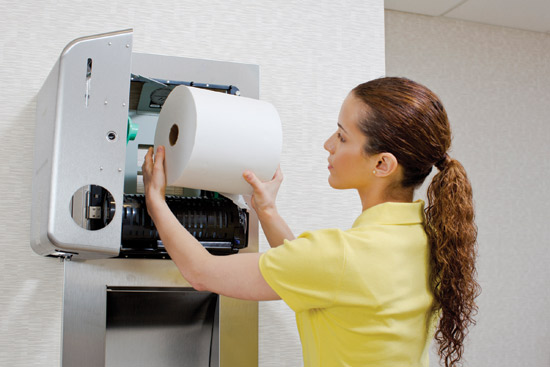
Photo courtesy of KIMBERLY-CLARK PROFESSIONAL*
Incorporating natural, non-tree fibers, such as bamboo and wheat straw, is another option that has been deployed to achieve sustainable paper products.
An effective paper towel system is predicated on a comprehensive maintenance system, in which staff are trained to remove the trash basket and replenish supplies of towels in a timely manner to keep restrooms comfortable and sanitary.
Air Dryers
Electric hand dryers that use heated air have been in use for decades, and have continually evolved to greener, more efficient versions. All electric hand dryers display most of their adverse environmental impact during use, specifically through energy consumption.
According to research in the aforementioned Westminster study, electric hand dryers don't dry hands as quickly as paper towels, sometimes taking up to 30 seconds to sufficiently do the job. In the process, germs are blown into the air. In terms of germ counts on fingertips after use, traditional hand dryers have shown a dramatic increase of 194 percent and a 14 percent increase in coliform bacteria on the units themselves. Not all units turn out to be truly touchless, with many being activated only via a power button, adding to the germ transmission problem. In terms of costs, they are only 7 percent less expensive than paper towels, according to the study.
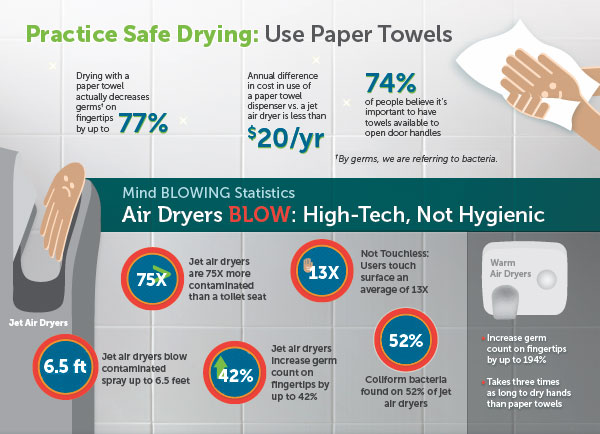
Graph courtesy of KIMBERLY-CLARK PROFESSIONAL*
Newer models of high-speed dryers provide higher-velocity delivery of the same amount of air as traditional models, score better marks in hand-drying time and energy efficiency. These models have been shown to sufficiently dry hands in 21 seconds, or 9 seconds faster than their traditional counterparts. However, that accomplishment seems to come at considerable expense. Germs collect into a trough, and then are blown into the air; in fact, jet air dryers have been found to blow contaminated air up to 6.5 feet from the unit itself. While germ counts on fingertips after use show a 42 percent increase, substantially lower than that of traditional dryers, the results for the increase in coliform bacteria on the surface of the units is significantly worse—a 52 percent increase vs. 14 for traditional dryers, with research pegging the surface jet air dryers at 75 times more contaminated than a toilet seat. Further, these machines are not in sync with one of the most critical elements of retarding the spread of germs—touchlessness. In fact, they have been shown to average 13 touches per use.
The aforementioned Mayo Clinic researchers also found that “Rubbing hands while under hot-air dryers leads to greater bacterial numbers and airborne dissemination,” and that rubbing hands may cause bacteria to migrate from hair follicles to the skin surface. Jet-air driers, while drying faster than hot-air dryers, resulted in the movement of air that only led to bacteria being spread further, according to the study.
Another big challenge with hand dryers is the water that drips down to the floor from users' hands and that can also be sprayed onto walls, leaving unsightly watermarks that leave a restroom looking soiled and ill maintained. In addition to cosmetic consequences, the water can also cause distinct health and safety hazards. While water dripping to the floor from one pair of hands seems inconsequential, but multiply that by hundreds, if not thousands, of users a day in high-traffic restrooms. That can add up to substantial pools of water on the floor that can create a breeding ground for bacteria and fungi, but can also pose a substantial risk of slips and falls. The Occupational Safety and Health Administration (OSHA) maintains that accidental falls account for the majority of general industrial accidents, with more than 12,000 injury cases, annually. A great percentage of slips and falls occur on wet surfaces and, because public restrooms typically have smooth floors made of tile, linoleum, or concrete, the risk of injury from a slip and fall is high. Another concern is that water could damage restroom walls and grout. When water pools on floor, it requires more frequent and longer cleaning times in the restrooms. Some facility managers handle that by purchasing floor mats, but these too need to be maintained. Newer models do have water-collection features such as drip trays, splashguards, ceramic plates that mount to the walls and wider-mouth dryers that direct water to a reservoir.

Graph courtesy of KIMBERLY-CLARK PROFESSIONAL*
Paper Towel Systems—Part of a Green Building
Many of today's paper towel systems, both the dispenser and the paper itself, have been designed with green building goals in mind, and can contribute to a facility's sustainability on a number of levels. Architects should consider both the paper quality and dispensing system when ensuring the best reduction of waste and germs. These help green buildings reduce their paper usage and ensure the building is a healthy, productive space.
LEED Credits
With the advancement of the green building movements have come green rating systems that quantify and credit sustainable materials and processes. The best known and most frequently deployed of these rating systems is the U.S. Green Building Council's (USGBC) LEED® rating system, now its fourth version. Under LEED v4 paper towel can contribute to a building earning up to two points toward LEED EB: OM certification.
Contributions are possible in the following categories:
EQc7
Green Cleaning Products and Materials. Credit can be earned for purchase of green cleaning materials and products such as floor finishes and strippers, disposable janitorial paper products, and trash bags. These include items used by in-house staff or outsourced service providers. These purchases must represent at least 75 percent, by cost, of the total annual purchases of these products that meet at least one of several standards, including those of the U.S. EPA, Green Seal, Environmental Choice, among others.
MRc4
Ongoing Consumables. Credit can be earned for purchases that represent at least 60 percent, by cost, of total ongoing consumables that meet at least one of the following criteria.
• Postconsumer recycled content. The content of purchases must meet or exceed the levels listed in the U.S. Environmental Protection Agency Comprehensive Procurement Guidelines. Products not covered by the Guidelines can get credit for their recycled content with no minimum.
• Paper and wood products. Paper and wood products must be certified by the Forest Stewardship Council® or USGBC-approved equivalent.
As there may be misinformation concerning the ability to accrue additional points for towel and tissue products, it is advisable to work closely with a LEED auditor and the USGBC to assure proper guidance.
Cutting Costs
Paper towels come in a few basic varieties: bleached; semi-bleached or natural; and unbleached or brown, all of which can be delivered in a roll or in folded form. In writing a manual for government purchases, California recycling specialists found that “People use more folded towels than roll varieties for a number of reasons. They pull folded towels out of dispensers by the handful, they rarely unfold towels before using them, and they take towels to their desks to mop up spills.” Dispensers control the amount of paper for roll towels and they are not as wide as folded towels so less paper is used per handwipe. Changing from folded towels to roll towels can produce a 25 to 35 percent reduction in toweling costs, over and above savings in packaging, cost, and labor. Roll towels are not required to be replaced as frequently as folded towels, and have faster production times as cutting, folding, and some packaging operations are unnecessary. The consultants found that dispensers that hold 800-foot rolls as well as stub rolls (partially used rolls) are the most cost-effective in maintenance terms.13
Responsible Paper Sourcing and Alternative Fibers
Forests and trees are essential to life. Trees clean the air, purify water and control erosion, and help maintain biodiversity by supporting plant and wildlife species. More than 1.6 billion people worldwide depend directly on natural forests for food, clothing, shelter, and traditional medicine. A well-managed forest will benefit wildlife and neighboring communities for generations. But nearly half of the earth's original forest cover is gone, much of it destroyed within the past three decades. As global demand for the world's resources increases, sourcing alternative fibers becomes critically important. Manufacturers are adopting sourcing programs that use a large amount of recycled fiber content, and using virgin fiber only from suppliers that are certified to recognized, credible forest management certification systems. Incorporating natural, non-tree fibers, such as bamboo and wheat straw, is another option that has been deployed to achieve sustainable paper products. In addition, using these products in a roll towel format that is in a controlled, hands-free dispense is optimal for furthering sustainability and health.
Minimizing Noise
In contrast to air dryers, particularly some of the newer models, the paper towel dispensing system is virtually silent. Some of the decibel levels of the high-velocity models can be worrisome in their effects on human health and safety. A recent study, for example, found that it is clear that having hands within the stream of the high-velocity airflow of the hand dryer creates significantly higher sound levels than with no hands in the air stream. Because hands are intended to be in the airflow when the device is used, the noise level that users will typically experience varies between the 95 dBA and 100 dBA, a level considered very loud and the equivalent to hearing a jet flyover at 1,000 feet away. Some of the higher-velocity dryers studied were loud enough to interfere not only with speech in the restroom, but in adjacent spaces as well.14
In another study, University of London scientists found that high-speed dryers can negatively impact certain vulnerable groups, including hearing aid users and the visually impaired, whose ability to navigate can be thwarted by loud noises. The same study found that the decibel level reached by the dryers was 11 times higher in a typical public toilet with corners and hard surfaces than in product testing laboratories.15 Architects should factor the differential in decibel level into their specifying decisions.
Reducing Consumption
Today's high-absorption towels, made possible by advanced air dried processes, can mean fewer towels are actually used to complete hand wiping or other tasks. This speaks to arguably the most valuable tenet of the reduce, reuse, recycle mantra: reduce. In terms of conservation of resources—both energy and material—the most sustainable option is unequivocally to reduce consumption, to make fewer materials. “Reduce” always scores the highest marks in terms of saving energy and materials; both reuse and recycle will require more energy and associated costs.
From Waste to Productive Use
With paper towel systems, a legitimate concern is the climatic and other environmental impacts they can have on the disposal side of the equation. Although paper towels are not recycled at most recycling plants because of equipment limitations, one emerging approach for effectively managing paper towel waste is composting.
As they break down easily and many brands are actually made of recycled fibers, and provided they contain no chemicals, pathogens, bodily fluids, or plastic linings, paper towels can be added to compost heaps. Many organizations are experimenting with composting their paper towels, in order to divert paper waste from landfills and turn it into a useful, organic material that can be used as a medium for plant cultivation. As part of its Zero Waste Policy, American University now composts paper towels from bathrooms campus wide. Other institutions including the University of Florida and Sustainable Berkeley Lab (SBL), one of the country's premier scientific research laboratories, are following suit, and other organizations are experimenting with the process. In a typical scenario, the University of Washington launched an 11-week-long restroom paper towel composting program in three of its high-traffic libraries to divert paper towels from the landfill in the spring of 2013. All 63 restrooms were converted to paper towel composting, with large trash receptacles relined with compostable bags and designated for paper towels only; a smaller trash receptacle was reserved for landfill items. By the time the pilot project concluded, nearly 8 tons of paper towels had been diverted from the landfill. The pilot program's paper towel composting effort is now expanding to more buildings on campus to help the university reach its goal of 70 percent waste diversion by 2020.
Specification Considerations
Because restrooms are not a revenue-producing aspect of any establishment, facility managers will want the most sanitary conditions and at the least cost, and designers of public restrooms may find themselves in a balancing act between these two goals. Good restroom design incorporates efficient layout and high-quality fixtures and accessories, and that is a function of the size of the space and type of facility, with the objective being to match the right quantity of items to the numbers of people that are anticipated to use the restrooms. Many aspects of restrooms, such as number of fixtures and their placement, are regulated by building code, which will vary according to jurisdiction. Public restrooms are required to be compliant with the Americans with Disabilities Act (ADA), too. Often, however, architects will exceed code requirements where it makes sense to create safer, more comfortable restroom facilities.
ADA Requirements and Universal Design
Standards are in place to guide architects in designing safe facilities that are comfortable for the maximum number of users. The passage of the ADA made it a matter of law that public facilities and services be fully accessible to people with disabilities. Developed by The Center for Universal Design at North Carolina State University, universal design is a broader concept. The Center defines it as “the design of products and environments to be usable by all people, to the greatest extent possible, without the need for adaptation or specialized design.” Think of doors that open automatically as a person moves toward them, for example. Universal design benefits not only people with disabilities, but strives for accessibility among by all user groups and considers such characteristics as age, gender, stature, race/ethnicity, culture, native language, and learning preference. While the ADA outlines the bare minimum necessary in order not to discriminate against people with disabilities, universal design is about best practices, which are always evolving and improving as more is learned about how to best meet the needs of various subgroups in the population.
Placement and Mounting Heights
For those with disabilities, restrooms can be difficult to navigate, especially for those in a wheel chair who often have to contend with items that are placed out of reach. Touch-free dispensers, battery operated or not, allow those with disabilities to more readily obtain towels. The ADA has requirements for proper placement of the towel dispenser to assure that it is low enough to the ground and not too far back behind a sink for use by disabled persons. There are specific height and space requirements for towel dispensers that are designed for people to approach it head on or come in parallel to the unit. To meet the criteria established by the act, paper towel dispensers should be installed a minimum of 15 inches or a maximum of 48 inches off the floor for forward-reaching range, or a minimum of 9 inches or maximum of 54 inches for those reaching from the side. Clear floor space of 30 inches by 48 inches is required in the approach to the dispenser. Further, ADAAG Section 309.4 states that: “Operable parts shall be operable with one hand and shall not require tight grasping, pinching or twisting of the wrist. The force required to activate operable parts shall be no greater than 5 pounds (22.2 N) maximum.”
Capacity and Layout
Good restroom design depends on a thorough understanding of the populations to be served. A large hotel will not have the same requirements as a K-8 school, nor will the needs of a high-traffic arena be the same as a those of a medical practice. How many and what type of users are expected? Will there by extensive use by handicapped or medial patients or other physically challenged user groups? Does expected traffic include a large number of elderly or children of stroller age? Positive answers to these questions may warrant exceeding code prescriptions on placement and number of fixtures. How often will the various populations use the facility on an hourly, daily, weekly, or other basis? Will there be peak usage periods, such as in a movie theater or arena? Answers to these questions will not only determine the optimum restroom size and layout, but also the number of restroom fixtures and supporting equipment as well as their optimum location. While the ADA and local building and plumbing codes stipulate many of these parameters, sometimes it is a matter of common sense to exceed code. Case in point is the distance between sink and towel dispenser, and even towel dispenser and waste receptacle. It is inconvenient for users who have just washed their hands to walk a distance to dry them. They may drip water on the floor or on their clothes; this may be especially irksome for a wheelchair user who may have to roll the chair wheels in order to reach the towel dispenser. It is advisable to minimize the distance between sink and towel dispenser and towel dispenser and waste receptacle to avoid water dripping on the floor, not only as a matter of individual comfort, but because of the associated consequences in hygiene, safety, and maintenance caused by wet restroom floors.
Hand and Face Drying: A Key Consideration for Public Health
As viruses tend to remain on hard surfaces for hours or even days, and even a simple handshake can spread germs exponentially, measures to prevent illness are critical. The CDC has long expounded on the fact that hand washing is an important component in keeping healthy and research indicates that hand drying effectively completes the process. While seemingly a simple act, drying hands has important public health implications. In specifying the appropriate approach to drying hands, next-generation paper towel dispensing systems offer architects a sleek, contemporary option that is fast, thorough, hygienic, user preferred, and comes with a number of environmental advantages.
Endnotes
1. http://www.mayoclinicproceedings.org/article/S0025-6196(12)00393-X/fulltext
2. In Absence Management 2011, SimplyHealth/CIPD P. 20 Graphic representation
3. Migraine: Diagnosis, Prevention And Treatment Jay A.Van Gerpen, M.D., Stephen Hickey, M.D., and David J. Capobianco, M.D.
4. KIMBERLY-CLARK PROFESSIONAL*
5. KIMBERLY-CLARK PROFESSIONAL*
6. Lennox Archibald, MD, PhD, Ray Rivera, MD and William Jarvis, MD, FIDSA, (1) College of Medicine, University of Florida, Gainesville, FL, (2) Jason and Jarvis Associates, LLC, Hilton Head Island, SC
7. Lennox Archibald, MD, PhD, Ray Rivera, MD and William Jarvis, MD, FIDSA, (1) College of Medicine, University of Florida, Gainesville, FL, (2) Jason and Jarvis Associates, LLC, Hilton Head Island, SC
8. http://plumbingengineer.com/april_12/faucet_feature.php
9. http://www.mayoclinicproceedings.org/article/S0025-6196(12)00393-X/pdf
10. http://www.mayoclinicproceedings.org/article/S0025-6196(12)00393-X/pdf
11. KIMBERLY-CLARK PROFESSIONAL*
13. http://www.conservatree.org/paper/PaperTypes/tissueoverview.shtml
14. Acoustics of energy-efficient hand dryers: Is this progress? By Jeffrey L. Fullerton (a) and Gladys Unger (b)
15. http://research.gold.ac.uk/7833/1/Drever_slides_from_COST_June_2012-update.pdf
 |
KIMBERLY-CLARK PROFESSIONAL * partners with businesses to create Exceptional Workplaces* helping to make them healthier, safer, and more productive. Key brands in this segment include: Kleenex, Scott, WypAll, Kimtech, and Jackson Safety. KIMBERLY-CLARK PROFESSIONAL *, located in Roswell, Georgia, is one of Kimberly-Clark Corporation’s four business sectors. To see how they are helping people the world over work better, please visit www.kcprofessional.com |

